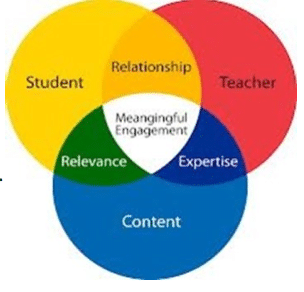Engagement – Designing for Learning in a Personal Mastery System
CompetencyWorks Blog
This article from the Reinventing Schools Coalition newsletter is designed to give you practices and opportunities to move students from compliance into engagement, an essential element for building a personal mastery system.
 Phillip Schlechty has enumerated a number of beliefs about viewing the student as a customer, volunteer, and a knowledge worker. What they have to volunteer is their attention and commitment. It is this perspective that drives the concept of teaching and learning from the student-centered approach. The idea of personal mastery is to require students to lead their own mastery learning in a personalized manner. This requires clear expectations, frequent feedback, and an engaged student.
Phillip Schlechty has enumerated a number of beliefs about viewing the student as a customer, volunteer, and a knowledge worker. What they have to volunteer is their attention and commitment. It is this perspective that drives the concept of teaching and learning from the student-centered approach. The idea of personal mastery is to require students to lead their own mastery learning in a personalized manner. This requires clear expectations, frequent feedback, and an engaged student.
For students to see the importance of the work, they must be willing to invest in their own learning. This requires the role of the teacher, student, curriculum, and assessment to change in the following manner. The idea of design must begin with the needs of the student(customer), and result in added value to the student.
- Value – In order for students to invest time into monitoring their own progress, there needs to be a reason involved with the assignment, as well as a connection with their interests.
- Commitment – Students need to see the importance of the work in order to be committed to it. Getting them “into” the work creates commitment.
- Persistence – Work needs to be challenging (a step above their level) in order for students to complete it. It adds value when they have to think further.
- Gratification – Easy/busy work does not motivate them to try. Create a growth mindset!
Essential Question: Knowing that compliance is not enough, how can we as teachers design more engaging lessons/learning environments that promote attention, commitment, persistence, meaning, and value?
Our students want: Lessons that are FUN, hands on, and relevant.
 As an organization reflects on these concepts, they must be honest with themselves at a personal and organizational level as to what degree they bring this level of “work” to students. This needs to be “the way we do business here!” In his book, Schlechty outlines 12 standards with essential questions to monitor an organization’s movement from compliance to engagement. These questions are wonderful for districts to use to provide structure for the important conversations.
As an organization reflects on these concepts, they must be honest with themselves at a personal and organizational level as to what degree they bring this level of “work” to students. This needs to be “the way we do business here!” In his book, Schlechty outlines 12 standards with essential questions to monitor an organization’s movement from compliance to engagement. These questions are wonderful for districts to use to provide structure for the important conversations.
Student – Teacher – Content (Meaningful Engagement) According to the Classroom Interaction Model of Student Engagement, meaningful engagement is most likely to arise when there is an environment with strong, positive student- teacher relationships: when students are interested in and committed to learning the subject matter because it is in some way relevant to them, and when teachers are well-versed in the content so as to maintain the rigor of the material and provide relevant challenges to the students. When students are meaningfully engaged they show a deep interest, involvement and investment in learning, take responsibility for their own learning, and support the learning of others.
Daniel Joseph is an Education Specialist with the Reinventing Schools Coalition (RISC) and an educational leader in the State of Maine. He has worked with his local school district, the State Department of Education, and a variety of other partnerships to transform the educational system. You can read a full biography here.